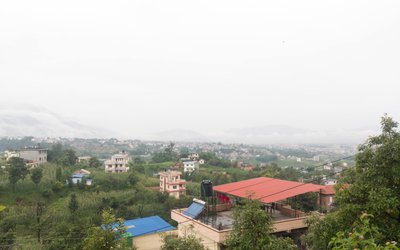How do you look at the overall trade situation of Nepal?
The growing trade deficit and trade imbalance are posing a great challenge before us. Our supply capacity constraints are one of the bottlenecks of this challenge. We need to increase the production to enhance our supply capacity. We need to mobilize the resources. There is the need to bring investment in the productive sector. We need to create a conducive environment for production.
What has the Commerce Ministry done so far?
The ministry has made public the Trade Policy, 2072. We are working to implement the programs to achieve the target as per the objectives envisaged by the policy. We have also launched the Trade Integration Strategy to achieve them. Under this strategy, there is a time-bound program to fulfill the objective of Trade Policy. It has two objectives. The first is to make the economy strong and sustainable. For this, Nepal needs to shift to trade leading to economic growth. Economy needs to be a stimulator to trade growth. There is the need to increase the GDP ratio on trade. Our aim should now be to maintain stability rather than to reduce trade imbalance.
How can you reduce the trade imbalance?
The target to reduce the trade imbalance is going to be more ambitious. There is no option before us other than to increase production and productivity. There is the need of inter-ministry and inter-agency coordination for this. There is the need to mobilize internal and international resources to fulfill the requirement. There is the need to have a delicate balance. This will contribute to the national economy and stabilize the trade imbalance. This also contributes to make trade an economic stimulator.
How do you aim to achieve this?
Increasing productivity and production can meet the target to stabilize the imbalance. To increase productivity and production, our programs and interventions should reduce the existing level of poverty in our society. The programs should also contribute to the social sector development. There are small and medium scale entrepreneurs, women and disadvantaged groups. These programs will enhance their capacity to achieve the objectives set by Social Development Goals by 2030.
What strategies do you have?
By pursuing two-pronged strategies like sustainability in domestic economy and trade led economic growth, SDG’s objectives can be achieved. The aim should be to reduce poverty and bring change in the livelihood of poor, disadvantaged groups and small and medium scale entrepreneurs. Our whole thrust needs to be job creation and income generation to enable these in the development of social sector. Our programs are directed towards achieving the SDG Goals. In this sense, we don’t have any confusion as our policy and strategy have clarity in principle. We are also working in the mobilization of international resources.
Don’t you foresee problems in the way to achieving these targets?
We do have some problems as well. Our findings have also shown that there are certain factors we cannot ignore. For example, the grass root level population is involved in the level production. We might have potential in agriculture sector or manufacturing sector or our capability in service sector might increase. All the small and medium enterprises and production units of local levels, involved in production sector, need to be integrated in the global value chain. Without this integration, the result cannot reach up to the group of people at the lower level of productive sector. There is some missing link somewhere -- we don’t have either the needed knowledge or the integration mechanism. We also want to take them simultaneously. Our views are that we need to carry out the program to address that component.
How do you see the demand for Nepali products?
The demand for our products is high in the international arena. The companies involved in export and import business have their supply chains. The problem right now is there is a growing demand from outside but lower productive capacity constraints have been creating problems. Our findings show that there is a production section, which has market linkage, but does not have the capacity to produce and other group, which has the capacity to produce, does not have market linkage. We are still unable to enhance our capacity. When a company does domestic sourcing, it is also unable to enhance its own capacity. Despite tremendous demand in international sector we are unable to supply them. Similarly, there is a growing demand in the domestic market as well but we are fulfilling them by importing the products. This situation is responsible to increase our trade deficit. Our society is consumption-based but we have not enhanced our productive capacity.
How do you see the size of production?
The size of production has not declined but it is a fact that we are unable to increase production as demanded by the market. Of course, our production fails to meet the existing demand. What I see is that our capacity has not enhanced as per the demand of the market and its demand. We need to look at this. We are unable to meet additional demand. As long as we cannot address this problem, it is impossible to address the challenges of trade imbalance and trade deficit. It is very difficult to see the contribution of trade in economic growth. Given the current level of short supply continues, it will further escalate the trade imbalance. Thus, we have identified the areas we need to work and priority sectors. For this, efforts of Commerce Ministry alone would not be sufficient and there is the need to have inter-ministerial and inter-agency partnership or collaboration between public and private, development partners as well.
What do you need to address the barriers in trade?
To trigger a trade growth, there is the need to address the barriers in market through improving infrastructures, increasing the connectivity and removing the barriers of market. The most important part is to minimize the cost of doing business. This will increase the competitiveness of our products as well. Even if we have good infrastructure and market linkage, our export cannot grow without enhancing the production capacity. Either we can improve our domestic production capacity or through the import, productive management. It is not only consumption but the product is also used to improve the production. It is very important to manage import and productive management and enhancement of capacity for export. Other important component is remove market access barriers and demands of quality product and infrastructure. They will further facilitate trade. We have included all these activities in our strategy paper.
What benefit does Nepal have to shift from Kolkata to Visakhapatnam port?
As a land-locked country, we are using Kolkata as a gate way port. There is an increase in the congestion in the port as well as our export and import has increased. Our domestic and international base of export and import used to be small. Now our scope has expanded and the existing infrastructures of Kolkata are inadequate for us. Thus, we have decided to use Visakhapatnam Port. For the new port, all legal arrangements have already been made. However, what is remaining now is to bring the product shipment from the port. Even Nepal Rastra Bank has issued notification to all commercial banks to issue LC from Visakhapatnam Port.
Can the port be usable now?
We have already developed the base for the use of the new port. We have already made provisions for things like authentication, service, railways. We have already designated the authentication process. We have already provided information required by them. We have already completed work but there is a certain procedural work to be done. It has already created additional opportunities. For this road map, the Ministry is ready to work. We know where the ministry needs to support and where it needs to facilitate and mobilize resources. Trade is one of the major components to achieve high growth and economic prosperity. One of the important parts is how to enhance the capacity. We don’t have any confusion on policy, what we need now is implementation.
How do you see the Nepal-China agreement in transit?
Nepal and China have already signed the protocol for transshipment. Only after the transit and transshipment agreement, the movement will begin. That is a framework agreement and certain article of that protocol principally agrees to use Chinese port.
Then why do we need further negotiations?
The article included in the agreement demands certain modalities like the names of the port and mode of transport and route. It requires the detailing. There is the need to hold several meetings to exchange the information. Protocol is quite a technical subject. Since we have the framework agreement, there is the need for more homework for the protocol and other annexes. If we have made the protocol overnight, it can be non-implementable. Thus, these negotiations can take a little time. There is the need to have several exercises to finalize the agreement. There is the need of a clear-cut arrangement to make it operational. We are in the process of agreement to operationalise the port.
- FOREIGN EXCHANGE: Largest Deposit
- Jul 22, 2024
- IMF: Approval Of SDR
- Jul 22, 2024
- NEPAL-KOREA RELATIONS: Fifty-Years Of Warm Relations
- May 31, 2024
- NEPAL-BRITAIN: Centenary Celebration
- May 31, 2024
- POLITCS: Forming New Alliances
- May 27, 2024
















